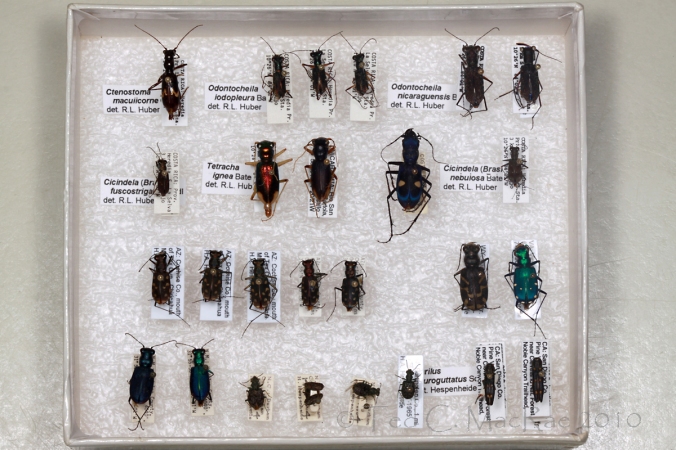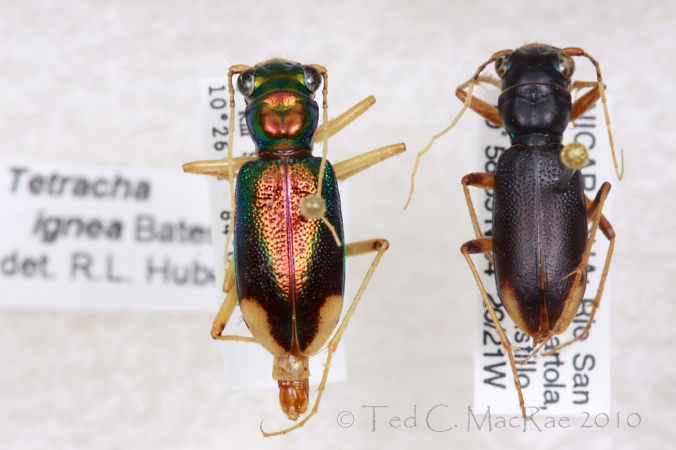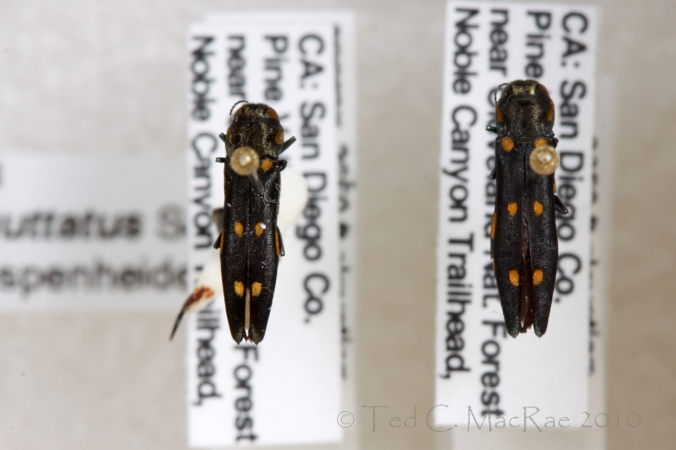Warning: post contains lots of hardcore, beetle-collector geekery!
A few weeks ago I got an email from fellow buprestophile Henry Hespenheide (Professor Emeritus, UCLA) asking if I needed any specimens of Agrilus coxalis auroguttatus – recently dubbed the “goldspotted oak borer” after it was discovered damaging oaks in southern California (Coleman & Seybold 2008). I replied that I did not have this species in my collection and that I would be grateful for any examples he could provide. Shortly afterwards, I received another message from him saying that he had just placed in the mail a small box with a male/female pair of that species – along with about two dozen tiger beetles for my enjoyment! Later that week I received the shipment at my office – I couldn’t wait to open it up and see what goodies were inside!
Opening a box of just received specimens is a little like opening presents on Christmas – you don’t know for sure what’s inside, but you know you’re gonna like it! This time was no exception, and I delighted as I realized the sending contained a dozen or so tiger beetles from Costa Rica and Nicaragua (a region in which Henry has spent many of his years studying the leaf-mining and twig boring buprestid beetles). My eyes were immediately drawn to two tiger beetles in particular – specimen #1 in the first row, and specimen #4 in the second row. Why these particular tiger beetles? Obviously they are among the more showy specimens in the sending, but more significantly both of them belong to genera not represented in my collection. The first of these is Ctenostoma maculicorne, representing also a new tribe for my collection (Collyridini, subtribe Ctenostomina). I’m glad Ron Huber had already identified this specimen, as I probably would’ve only been able to determine the genus. Beetles in this group are ant mimics, but in a much different manner than our U.S. ant-mimics (Cylindera cursitans and Cylindera celeripes). Those latter species are found strictly on the ground (as are all U.S. tiger beetle species), while species of Ctenostoma are largely arboreal. Troy Bartlett at Nature Closeups has some great photographs of another species in this genus seen last January in Brazil (Caraça Natural Park, Minas Gerais) that show just how ant-like these beetles can appear as they crawl about on twigs and branches.
Despite lacking an identification label, I recognized the second specimen instantly as Pseudoxycheila tarsalis, dubbed by Erwin & Pearson (2008) as the “Central American montane tiger beetle.” Pseudoxycheila is a rather large Neotropical genus (21 known species), but only P. tarsalis occurs north of South America. Morgan Jackson at Biodiversity in Focus photographed an individual of this species during his visit to Costa Rica this past summer. Its brilliant coloration is not only delightful to look at but also apparently aposematic in nature – Schultz and Puchalski (2001) found that benzene-like compounds isolated from the beetle’s pygidial glands are distasteful to humans, adding support to the potential of a Müllerian mimicry association with stinging mutillid wasps in the genus Hoplomutilla, which they resemble. Note also the curious spine on the frons extending out over the mandibles – maybe it not only grabs its prey with its toothy jaws but also “stabs” it for extra measure (just kidding – though I do wonder about the function of that spine. I’m not aware of its presence in any other genus of tiger beetles).
I also noted an interesting pair of tiger beetles that looked very different from each other, yet were both identified by Ron Huber as Tetracha ignea. This species was recently synonymized under the nominotypical form of T. sobrina (Naviaux 2007) – the “ascendent metallic tiger beetle” (Erwin & Pearson 2008), a highly variable species with numerous described subspecies occurring in southern Mexico, Central America, northern South America, and the West Indies. The specimen on the left has the normal appearance of T. sobrina sobrina, but the specimen on the right looks like it might have suffered some chemical discoloration (a common occurrence among collected tiger beetle specimens).
Update 16 Dec 2010, 12:00pm – I just learned from Henry that the Tetracha specimen on the right (from Nicaragua) was not seen by Ron Huber and, thus, is likely not conspecific with the specimen on the left (T. sobrina from Costa Rica). That’ll teach me to blindly accept what I see but does not seem right. Now, time to pull out my copy of Naviaux (2007) and test my abilities to work through a key written in French!
There are several other interesting species in the sending – some determined (two species each of Oxycheila and Brasiella) and others that I need to look at more closely. You may note on the bottom row a few specimens of a species of Elaphrus – a genus of true ground beetles that often fool collectors by their strong resemblance to tiger beetles (looks like they fooled Henry, too). As for the beetles that were the reason for this shipment in the first place, these are shown in the image below. Agrilus coxalis auroguttatus was recently discovered as the cause of significant mortality in several species of oak trees in San Diego County (Coleman & Seybold 2008), thus joining the introduced Agrilus planipennis (emerald ash borer) and several native Agrilus spp. on the ever-growing list of buprestid beetles achieving economic pest status in North America. This subspecies, known for many years from southern Arizona (where it is not a pest), is curiously widely disjunct from nominotypical populations in southern Mexico. Its sudden appearance in southern California has all the hallmarks of being a human-aided introduction, although natural range expansion remains a possibility.
My deep appreciation to Henry Hespenheide for gifting me these specimens and for his always enlightening and often entertaining correspondence over the years.
REFERENCES:
Coleman, T. W. and S. J. Seybold. 2008. Previously unrecorded damage to oak, Quercus spp., in southern California by the goldspotted oak borer, Agrilus coxalis Waterhouse (Coleoptera: Buprestidae). The Pan-Pacific Entomologist 84:288–300.
Erwin, T. L. and D. L. Pearson. 2008. A Treatise on the Western Hemisphere Caraboidea (Coleoptera). Their classification, distributions, and ways of life. Volume II (Carabidae-Nebriiformes 2-Cicindelitae). Pensoft Series Faunistica 84. Pensoft Publishers, Sofia, 400 pp.
Naviaux R. 2007. Tetracha (Coleoptera, Cicindelidae, Megacephalina): Revision du genre et descriptions de nouveaus taxons. Mémoires de la Société entomologique de France 7:1–197.
Schultz, T. D. and J. Puchalski. 2001. Chemical defenses in the tiger beetle Pseudoxycheila tarsalis Bates (Carabidae: Cicindelinae). The Coleopterists Bulletin 55(2):164–166.
Copyright © Ted C. MacRae 2010





As someone who’s primary interest is only to photograph insects in the wild, nothing usually disturbs me more than seeing pinned insects. The exception, of course, being collections by trained entomologists. Thanks for showing your examples, and contributing so much needed information to novices like myself.
Hi Tom – I come from the other end, spending nearly 3 decades collecting insects before I took an interest in photographing them in the wild. While I frequently defend the former, I recognize the need for following a “code of ethics” in doing so. I appreciate your open mind on the subject – perhaps you might be interested in the dialogue about this very topic that was sparked by this comment on one of my earlier posts.
Hi Ted,
Thanks for the link, and I couldn’t agree more. It’s the indiscriminate collection for the purpose of photographing that bothers me, since specimens are usually discarded. But the benefit gained from knowledgeable people like yourself helps generations to come. Entomologists (and others in similar fields) are deserving of much more recognition for the work they do.
Again, my thanks and happy holidays!
Kind remarks, indeed – thank you!
Christmas came early this year! Glad to see your collection is ever growing!
Christmas, indeed! Usually more swapping/shipping occurs in Jan/Feb, so let the holidays continue!
Very nice blog Ted, as always! I remember receiving parcels like these while living in South Africa-full of diversity and species new to me!
Hi Art – ah, South Africa and its marvelous diversity of insects. My two weeks there with Chuck and Rose were one of the best insect collecting experiences I’ve ever had.
Now THAT is a nice present!!!
Can you explain this a bit?
Yeah, those guys got me this summer, remember? I was SO pumped about finding tigers in the north (and then sad when I realized I didn’t. And then happy to find something still cool). I think I’ve learned my lesson though; I immediately thought “Elaphrus” when I saw those specimens. They’ve got a very distinct shape once you know what you’re looking at.
Well, it seems the chemical discoloration theory was usurped by an explanation much more mundane – it actually is a different species (see update)! 🙂
Regardless, tiger beetles seem to be easily discolored when fat tissues in the body break down and leach into the cuticle after curating. The problem is excacerbated in specimens of spring/fall species collected in the fall (apparently by the time they’re collected in the spring they have used up much of their fatty reserves), and killing them in ethyl acetate makes it even worse. Because of this, many collectors still use cyanide as a killing agent, despite the tremendous hazards associated with its use. Others drop them into 70% ethanol and transfer to ethyl acetate for complete degreasing before mounting. I see no reason to carry a bunch of liquid around in the field, so I continue to kill them in vials with a few drops of ethyl acetate on tissue paper, but rather than letting them dry out I then transfer them to liquid ethyl acetate once I return home and let them degrease that way. Once you degrease them part way you’re committed – if you don’t complete the job the remaining fats (which are now highly dissolved) will stain the specimen, so it usually takes a couple changes of ethyl acetate every few days until the liquid stays completely clear. After that, they can be mounted (and as a bonus the ethyl acetate killing/treatment keeps them nicely relaxed for easy mounting).
I do remember your Elaphrus escapade, and I almost linked to it as an example before thinking you might not appreciate it. Glad to see you can laugh about it, too. 🙂
I have NEVER heard of “de-greasing” Not once. You’d think that would have come up somewhere in my studies by now!!! Thanks for the thorough explanation; that’s a good set of procedures that I’ll tuck away for future reference. Is this a common problem with insect specimens generally? I can’t imagine it is restricted only to beetles but perhaps the effects are more prominent or problematic when elytral patterns/characteristics are diagnostically important?
Not once. You’d think that would have come up somewhere in my studies by now!!! Thanks for the thorough explanation; that’s a good set of procedures that I’ll tuck away for future reference. Is this a common problem with insect specimens generally? I can’t imagine it is restricted only to beetles but perhaps the effects are more prominent or problematic when elytral patterns/characteristics are diagnostically important?
It isn’t a problem for most insect groups, but rather a few specific groups that tend to have a lot of fatty reserves in their tissues. Tiger beetles are one group, sesiids (clearwing moths) and cossids (carpenterworm moths) as well – there may be others that I am unaware of. Beetles, for the most part, are the least problematic of insects to deal with curatorially.
Lovely to see a box of pinned, identified specimens! Thanks for sharing! We’ve all done the Elaphrus/ tiger beetle thing (the other ones to watch are Colliuris and Asaphidion)
Hi Max, thanks for the comment. I wasn’t aware of Asaphidion until I looked it up – apparently its a recent import that we don’t have here in the Midwest. If I saw one of those, I would have immediately confused it with Elaphrus! 🙂
Pseudoxycheila would seem to be a unicorn, or perhaps a rhinoceront.
I was looking at that spine under the scope, and it’s really an incredible structure.
Wild! I hadn’t noticed that! Ted, is that kind of structure common in tigers from the southern hemisphere?
Like I said, I’ve never seen such a structure until I noticed it on this specimen. I scanned through the images in my copy of Erwin & Pearson (2008), which has dorsal habitus photographs of a representative species of all Western Hemisphere genera, and didn’t see one on any of the other genera besides Pseudoxycheila. My attempts to find information on the structure have so far come up empty, which seems odd given its apparent uniqueness. Perhaps it is a sexual character (my specimen is a male) – I just don’t know.
That would make sense. It would be nice to get your hands on a female to compare.
“…Now, time to test my abilities to work through a key written in French!”
Bonne chance, mon ami.
Meilleurs vœux,
D.
Well, it’s certainly easier these days with the ability to do quick and easy translations on the web. And actually, even though I’ve never studied French, I’ve read enough species descriptions and keys written in French by some of the older authors to have an idea.
Желаю всего наилучшего в новом году большой 😀
What a pleasure it is to see well curated, well labeled specimens. Kudos to Henry.
С наилучшими пожеланиями к Вам и Вашей семье в новом году,
D.
Igualmente!
Growing up in areas of Germany with lots of creeks and forests, but heavy clay soil, I had seen many Elaphrus cupreus long before finding my first Tigers
So I guess your first tiger beetle fooled you as being an Elaphrus? 😀
Hello Ted
What a surprise to be gifted specimens from the World Famous! I was wondering when I was going to get a box of Staphs from your neck of the Nearctic!
On the Elaphrus topic! Years ago I was gifted a box (with specimens labeled Elaphrus) from another Entomologist with the new letters behind his name (PhD) for some identification work I had done for his dissertation. Upon opening said box I immediately said quietly “not Elaphrus!” Yet another common error as the specimens were Carabidae: Opisthius richardsoni Kirby.
Happy Holidays
rr
Hi Rod – sadly, staphs have never enjoyed the attention from me necessary to end up as pinned, labeled specimens in my collection. I might have a specimen or two of Creophilus maxillosus, whose large size might have impressed me in my younger, more generalist days, but I doubt that is something you are still looking for.
Now, if I were to run into Megalopinus caelatus, that would certainly make it into the collection!
Looks like Elaphrus is deceptive in either direction!
Hello Ted (or anyone else that can answer my question):
I am curious what species is in the 3rd row, 2nd from the right in the above image? (specimen 6 of the 3rd row, I believe of the “A nice selection of tiger beetles and buprestid beetles.” collection)
I had one of these beetles fly into my car at the confluence of the Illinois & Misissippi rivers yesterday. Thanks a lot.
Dave
Hi Dave – that would be the Oblique-lined Tiger Beetle (Cicindela tranquebarica). There are a number of tiger beetle species that look like this one, although occurrence along the Big Rivers of the state in early spring would certainly be consistent with this species.
Thanks a lot!
Pingback: Not an emerald ash borer — but what is it? | Millard Fillmore's Bathtub